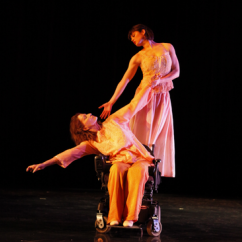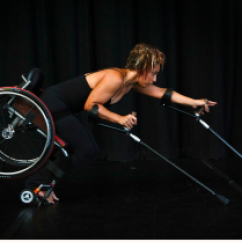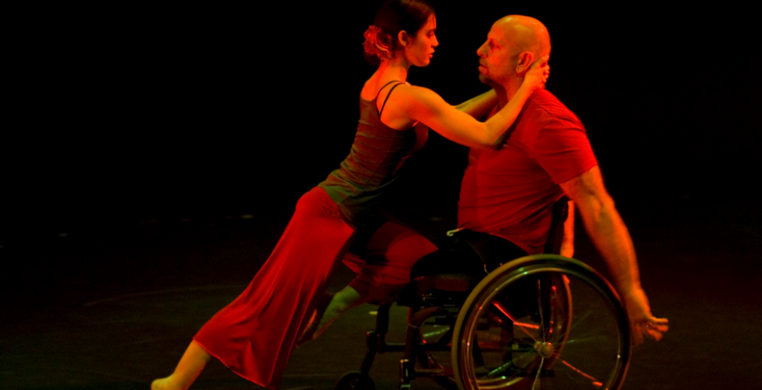Lyricism and poetry are not usually the first words that come to mind when you think of wheel chairs, and yet they are exactly what characterize MOMENTA dance company’s “Counter Balance VI,” presented at the National Museum of Mexican Art on Saturday, September 19th, in commemoration of the 25th anniversary of the Americans With Disabilities Act.
The program of nine works, developed in collaboration with Access Living and Bodies Of Work, seamlessly integrated conventionally mobile with alternatively mobile dancers in a richly varied program of solos, duets, and one group piece.
In a quote from the website of Bodies of Work, housed at the UIC Department of Disability and Human Development, the poet Neil Marcus states, “Disability is not ‘a brave struggle’ or ‘courage in the face of adversity’...disability is an art.”
MOMENTA’s physically integrated dance is living proof of that statement, and “Counter Balance VI” provided a stunning fulfillment of the mission to create “art (that) illuminates the disability experience.” Fascinating, sometimes exquisite, and certainly eye-opening and consciousness-raising, it was also much more than that, not that it needed to be. I found, as the concert unfolded its gems one by one, that I had no need to qualify the work. It stood on its own as dance, albeit with props unlike any I’d ever witnessed before, performed by dancers, some of whose impressive artistry and virtuoso technique derived from physical differences we usually think of as limiting.
It was clear from the opening moments of “Stay,” choreographed and performed by Kris Lenzo and Linda Mastandrea, that we were watching choreographic art performed with artistic integrity and aesthetic sophistication that few could imagine without seeing it first-hand. Lenzo and Mastrandrea, dancing a sensual courtship ritual on wheels, swirled around each other in sweeping arcs that eventually converged in something reminiscent of ballroom dance. Spatial navigation had the ebb and flow of the breath impulse, exhilarating in the rush and speed of intersecting arcs. The rolling chairs, adapted from conventional wheel chairs to enable full range for the athletic and artistic demands of dance, were an organic extension of their bodies, taking on the plasticity of human movement with expressiveness one would never have thought possible of a mechanical device. Arms used to thrust the wheels into motion also caressed and wrapped around the curved wheel rims in one of many gestures that crystalized the unity of body and machine. Lenzo is a powerful dancer whose keenly focused stage presence exudes both warmth and dramatic intention. His magnificent arm span extended energy across the space in breath-driven arcs, suspending and falling, reaching and retreating, in a constant play of inward and outward movement that derived from his highly-articulated spine. Ms. Mastandrea was a winsome partner to his lead, as they joined hands like ice dancers in the swoop and dip of a romantic couple, navigating and propelling themselves through space with subtle torso shifts and spirals that merged into a mesmerizing organic whole.
“Seated Warrior Woman,” choreographed by Anna Leo of Atlanta’s Emory University, begins with a woman’s voice. “Say woman,” she says, as solo dancer and guest artist Laurel Lawson begins this bold self-portrait. Sharp head turns are echoed in short, abrupt chair rotations, jarringly defiant. Early on, Lawson moves downstage and, strapped to her chair, suddenly tips over, eliciting a gasp in the audience and an impulse to rush to the fallen dancer’s aid, but no, this is part of the choreography’s high-risk emotional landscape of danger. Core impulse underlies Lawson’s skill and technical command. While arm gesture dominates movement invention, it is the torso and head that propel dancer and chair in her quest for the outermost boundaries of her world. Steve Everett’s effective percussion and flute score add to the breath and emotional build of the piece. Lawson folds and rocks her arms, then expands them into wings seemingly in flight as she bows her torso and melts herself out of her chair and onto the floor in a fall, roll and tilt that explores some of the same, seated movement material on a different plane before returning to the chair. Beautiful, arresting, and bold, the dance gives testimony to women’s empowerment.
Dancer/Choreographer Ginger Lane’s “Prayer” is a heartrending duet for mother and daughter, angel and mortal, body and soul, and two dancers. Lane, was a professional dancer before she lost use of her legs in a ski accident in 1984. Dancing in a motorized wheel chair, she partners MOMENTA associate artistic director Anita Fillmore Kenney in a dance replete with lush, lyrical flow, set to piano music of Franz Schubert. The two mirror each other in body release, the conventionally-mobile Kenny riding Lane’s chair, extending in a penché arabesque over Lane like a guardian angel. Lane utilizes the architecture and mechanized motion of the chair to design a series of exquisite lifts in ingenious partnering, alternately cradling Kenney, supporting her, and extending her reach. The chair provides spatial levels that allow Lane to achieve stunning visual pictures, the two bodies forming parallel lines of torsos and arms on separate planes. Kenney, an ethereally lovely dancer, stands on the back of Lane’s chair, moving as if in flight, the simplicity of the music and movement together evoking a sense of something eternal, and perhaps even the whispering voice of Isadora Duncan hovering in the beyond.
 "Prayer"
"Prayer"
Guest artist Alice Sheppard’s “So, I Will Wait” is a highly tactile piece that begins with the dancer/choreographer grazing the floor from her chair, as if sifting through sand on a beach. Her body sways, she shifts, lets go, and propels herself with her fingertips until she tips the chair forward, gently off-balance. Using wide body circles, her powerful arms reach overhead and beyond, her spine alive in a sensual arch and collapse of arms into herself. Subtle articulation of the ribcage and spine ripple out through head and arms. She cradles the wheel of her chair like another body part, arches back to tip over and somersaults into a shoulder stand, the glistening wheels of her chair poised in space above her body. Stepping forward on fingertips, she propels herself to finish face-down in supplication on the floor.
 Alice Sheppard
Alice Sheppard
“Tango #4, choreographed by MOMENTA company member Sarah Najera, is a steamy interlude of fun, danced to perfection by Mr. Lenzo and Ms. Kenney.
MOMENTA dancer Jessica Martin’s solo “Skater” uses the choreographer/dancer/writer’s own poem in a voice-over to evoke the thrill of ice skating, inviting the audience to “come into my journey with me, to my heart,” and so we do. Martin dances her poem from her motorized chair, her torso and arms echoing her words: “My nerves soften and I am present...very present,” filling the space “like a bird with breath and intention.” The “thunder of silence” pervades the poetic simplicity of being, evoked with full body gesture and arms that embrace the space around her with grace and gratitude.
Lawson and Sheppard’s duet, “Excerpt from Snapshot (Minsky’s Burlesque, New Jersey, ca. 1954” is a marvel of choreographic invention, humor, and wheelchair pyrotechnics. The two women wrangle through something akin to contact improvisation, balancing upon each other, lifting, crawling under and over each other, and finding themselves in startling spatial juxtaposition at opportune moments in the song, “Little Things Mean A Lot,” sung in a recording by Jane Mansfield.
During the group curtain call at the end of the concert, a piece of scenery just about felled Jessica Martin. First screams and then, as she took it in stride, laughter from audience and performers alike, broke across the “fourth wall” of the proscenium in both directions and cemented the bond of solidarity between audience and dancers, all of us grateful that all of our diverse and wondrously unique attributes can bring us together for such celebrations of the human experience.

